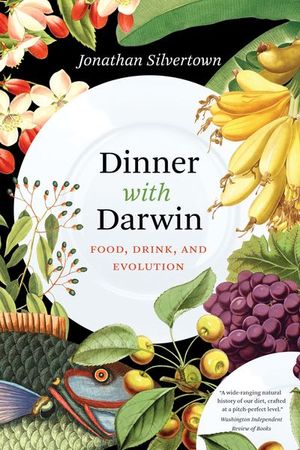Dinner with Darwin
Published by The University of Chicago Press
A “delectably erudite” study of how natural selection has shaped the foods we eat: “This intricate scientific banquet is a marvelous read: bon appétit.” —Nature
What do eggs, flour, and milk have in common? They form the basis of waffles, of course, but these breakfast staples also share an evolutionary function: eggs, seeds (from which we derive flour by grinding), and milk have each evolved to nourish offspring. Indeed, ponder the genesis of your breakfast, lunch, or dinner, and you’ll soon realize that everything we eat and drink has an evolutionary history. Dinner with Darwin is a multicourse meal of evolutionary gastronomy, a tantalizing tour of human taste that helps us understand the origins of our diets and the foods that have been central to them for millennia—from spices to spirits.
A delectable concoction of coevolution and cookery, gut microbiomes and microherbs, and both the chicken and its egg, it reveals that our recipe cards and restaurant menus don’t just contain the ingredients for culinary delight. They also tell a fascinating story about natural selection and its influence on our plates—and palates. Digging deeper, Jonathan Silvertown’s repast includes entrées into GMOs and hybrids, and looks at the science of our sensory interactions with foods and cooking—the sights, aromas, and tastes we experience in our kitchens and dining rooms. As is the wont of any true chef, he packs his menu with eclectic components, dishing on everything from Charles Darwin’s intestinal maladies to taste bud anatomy and turducken.
Our evolutionary relationship with food and drink stretches from the days of cave dwellers to contemporary crêperies and beyond, and Dinner with Darwin serves up scintillating insight into the entire awesome span. With a wit as dry as a fine pinot noir and a vast cache of evolutionary knowledge, Silvertown whets our appetites—and leaves us hungry for more.
“The book left me feeling as if I had attended a dinner party, where foodies, historians, and scientists mingled, sharing vignettes on various food-related topics.” —Science
What do eggs, flour, and milk have in common? They form the basis of waffles, of course, but these breakfast staples also share an evolutionary function: eggs, seeds (from which we derive flour by grinding), and milk have each evolved to nourish offspring. Indeed, ponder the genesis of your breakfast, lunch, or dinner, and you’ll soon realize that everything we eat and drink has an evolutionary history. Dinner with Darwin is a multicourse meal of evolutionary gastronomy, a tantalizing tour of human taste that helps us understand the origins of our diets and the foods that have been central to them for millennia—from spices to spirits.
A delectable concoction of coevolution and cookery, gut microbiomes and microherbs, and both the chicken and its egg, it reveals that our recipe cards and restaurant menus don’t just contain the ingredients for culinary delight. They also tell a fascinating story about natural selection and its influence on our plates—and palates. Digging deeper, Jonathan Silvertown’s repast includes entrées into GMOs and hybrids, and looks at the science of our sensory interactions with foods and cooking—the sights, aromas, and tastes we experience in our kitchens and dining rooms. As is the wont of any true chef, he packs his menu with eclectic components, dishing on everything from Charles Darwin’s intestinal maladies to taste bud anatomy and turducken.
Our evolutionary relationship with food and drink stretches from the days of cave dwellers to contemporary crêperies and beyond, and Dinner with Darwin serves up scintillating insight into the entire awesome span. With a wit as dry as a fine pinot noir and a vast cache of evolutionary knowledge, Silvertown whets our appetites—and leaves us hungry for more.
“The book left me feeling as if I had attended a dinner party, where foodies, historians, and scientists mingled, sharing vignettes on various food-related topics.” —Science
BUY NOW FROM
COMMUNITY REVIEWS
